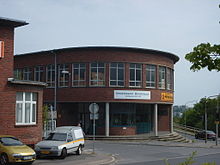Muensterbusch zinc hut
The zinc smelter Münsterbusch or Heinrichhütte was a zinc reduction smelter in the Aachen district in western North Rhine-Westphalia . It is located in the area of today's city of Stolberg (Rhld.) In the city region of Aachen . The zinc works was named after Emperor Heinrich II (973-1024). The initials SS for Société Stolberg were used as trademarks of Stolberger Hüttenzink .
The Münsterbusch zinc hut was not the first zinc hut in the Aachen district - this was the Eschweiler zinc hut Velau - but the first of its kind in western Germany to achieve economic importance.
history
The zinc smelter was built from 1834 to 1837 by the industrialist John Cockerill in the immediate vicinity of the James mine operated by his brother James Cockerill in the Münsterbusch district, which was then part of the Büsbach community , and brought it into the newly founded Metallurgische Gesellschaft zu Stolberg in 1838 . From their successor companies, the limited partnership de Sassenay & Cie. , the Stolberger Gesellschaft and the Stolberger Zink , the Münsterbusch zinc smelter was operated continuously until 1967.
Initially, the Münsterbusch zinc smelter was operated with four double reduction furnaces with 84 retorts each.
When switching from calamine to Röstblende around the middle of the 19th century, a muffle geometry tailored to this new raw material was developed. In contrast to the very high Silesian and the circular Belgian muffles, a shape with an oval cross-section was created, which was called the Rheinische Muffel . This type of muffle was later used all over the world in the zinc smelters that worked with horizontal muffles.
In addition to a roasting hut and a mouflerie, the Münsterbusch zinc hut was also affiliated with a rolling mill for the production of rolled zinc . a. the well-known zinc printing plates were made.
To dispose of the exhaust gases, especially the roasting gases and later their residual components, an extraordinarily high chimney was built right next to the zinc smelter, which was called "Langer Hein".
In 1887 it was connected to the railway network via the now demolished Münsterbusch station on the Stolberg – Münsterbusch railway line.
In the late 1920s, the Münsterbusch zinc smelter developed the Thede process for smelting zinc from zinc dust and other intermediate products from zinc extraction. From 1930 this procedure was also used internationally.
In 1935 it came with the incorporation of Büsbach to Stolberg (Rhld.) .
In World War II a was forced labor camps of Stolberg zinc with 106 men on the premises of the zinc smelter in Cockerillstraße . When after the World War the roasting works and the sulfuric acid plant of the zinc works had to be demolished due to the effects of the war, all zinc ores, including those for the Münsterbusch, were roasted in Nievenheim .
Between 1956 and 1958, a new, highly mechanized mouflerie was built in the zinc smelter. This plant also supplied the Nievenheim zinc smelter, which belongs to the Stolberger Zink group, with ready-mixed clay or with already pressed, dried muffles.
In the 1960s, the zinc smelter had an annual capacity of more than 30,000 t of zinc. The actual reduction smelter consisted of two halls with twelve reduction ovens each. Each furnace contained 120 to 132 muffles arranged in three rows one above the other. The furnace work was largely mechanized through the use of clearing and loading machines.
In 1967 the hut was closed. The Münsterbusch zinc smelter left behind extensive heaps such as the Fettberg and Kohlbusch heap, which have since been recultivated.
Individual evidence
- ↑ St. Heinrichshütte - Metallurgische Gesellschaft zu Stolberg on: HisTech eV Association for regional technical, economic and social history ( Memento of the original from November 28, 2014 in the Internet Archive ) Info: The archive link was automatically inserted and not yet checked. Please check the original and archive link according to the instructions and then remove this notice.
- ↑ Zinc: Processing of ores and extraction of zinc at: mineralienatlas.de
literature
- Stolberger Zink, The History of a Metal , Aachen 1957.
Coordinates: 50 ° 46 ′ 36.5 ″ N , 6 ° 12 ′ 55.9 ″ E


